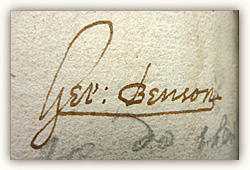
|
Gervase Benson |

Carlisle: Cumbria Record Office MS D & C Thomas Machell vol. 2
Image © Dean and
Chapter of Carlisle Cathedral, and reproduced by their kind permission
Gervase Benson (d. 1679) was a lawyer and influential social figure who joined the Quaker movement. He had residences at Haygarth, Cautley, above Sedbergh (now the Cross Keys Temperance Inn); at Kendal; and at Borratt (now Borrett) in Sedbergh, where George Fox attended a Separatist meeting on 6 June 1652. He was a notary public and, later, Commissary of the archdeaconry of Richmond, dealing with probate matters. In December 1640 he was elected to the Kendal corporation, and quickly advanced to become an alderman in April 1641, mayor of Kendal at Michaelmas 1644, and a Justice of the Peace. Despite his distinguished career, once a Quaker,
He generaly stiled himselfe Husbandman, Notwthstanding yt he had bene a Collenell, a Justice of peace, Mayor of Kendall, & was Comisery in ye Arch Deaconry of Richmond before ye late Domistick Warrs, yett, as an Humble disciple of Christ, downed these things. 1
He supported the parliamentary interest in Kendal, which led to swings in his fortune. He was briefly imprisoned in Skipton Castle by the Royalists in 1644. As Colonel Benson, he commanded Kendal’s small garrison in 1645, though there is no evidence that he served in the New Model Army. After Parliament's victory in the Second Civil War he rose to prominence as a regional administrator and became known in London. In 1650, he and his fellow alderman John Archer wrote to the House of Commons pointing out that a large section of the corporation had not subscribed to the Oath of Engagement (‘to be true and faithful to the Commonwealth of England as it is now established’); the result was a directive that removed royalist and conservative members from office.
Benson became convinced as a Quaker on 6 June 1652, when George Fox visited the Separatist group he had gathered at Sedbergh. He was an active proselytiser and organiser, ‘appointing Meetings in ffresh places’, such as Dent, and, it has been argued, deserves a much larger place in the history of the movement in the North West than he has been given. He went to London in the Quaker cause in 1653. At home, he lent his legal training to the various disputes in which they were involved. He was on the Bench at the trial of James Naylor in the Westmorland sessions at Appleby (11 January 1653) and attempted to intervene on his behalf.2 In September 1653, he was in turn excluded from Kendal Corporation for his Quaker activities (he took part in public debates on religion), but he was still able to offer some protection to his co-religionists, and remained an important spokesperson for the movement in legal and administrative matters. He was particularly active in the arguments against tithes, and the taking of oaths, which affected such practical matters as probate. In December 1653 he lobbied Parliament against the gathering of tithes, and his pamphlet, Cry of the Oppressed (1656) spoke out against this and publicized Quakers who were persecuted for non-payment. His legal training and office enabled him to contribute to printed debates on Quakers’ difficulties with the oath of abjuration. He published A true testimony concerning oaths & swearing &c in 1669, and A second testimony concerning oaths and swearing in 1675.
Benson’s family were also actively involved in the public promotion of Quaker precepts. Dorothy, whom Benson had married in 1634,3 was imprisoned for at least a month at York in December 1653 with her neighbour Anne Blaykling. Dorothy gave birth in prison to the Benson’s youngest son Emmanuel.4 She died and was buried at their house in Haygarth on 28 February 1656. Benson married Mabell, widow of John Camm (another early Quaker activist) of Camsgill, in 1660. He moved back to Kendal c.1678, died there and was buried in the Quaker burial-ground on 5 May 1679. He left a widow, Mabel, three sons and five daughters.
Close window to return
Further Reading
Joseph Besse A Collection of the sufferings of the people called Quakers, 2 vols (London: Luke Hinde, 1753)
William C. Braithwaite The Beginnings of Quakerism edited H. J. Cadbury (Cambridge: Cambridge University
Press, 2nd edition 1955)
David Boulton Early Friends in Dent (Dent: Dales Historical Monographs, 1986)
C. B. Phillips ‘Gervase Benson’ in The Oxford Dictionary of National Biography (online edition: your
local library card will usually give you access)
C. B. Phillips ‘Colonel Gervase Benson, Captain John Archer and the corporation of Kendal, c.1644–c.1655’ in
Soldiers, writers and statesmen of the English Revolution edited Ian Gentles and others
(Cambridge: Cambridge University Press, 1998) 183–201.
‘The First Publishers of Truth’: being early records, now first printed, of the introduction of
Quakerism into the counties of England and Wales edited Norman Penney (Friends Historical Society
Journal Supplements 1-5; London: Headley; New York: Taber, 1907)
With thanks to David Boulton for a sight of his unpublished work on Gervase Benson.
1. First Publishers of Truth page 251: see ‘Other Sources’ on index page. Return
2. James Naylor and George Fox Several Petitions Answered That were put up by the Priests of Westmorland ... (London: Giles Calvert, 1653) 51–3; contains text of a submission by Benson. Return
3. Pallot's Marriage Index said to be from ‘York Archdiocese’. Bride given as Dorothy Dawson. May not have been the right Gervase and Dorothy. Return
43. Penney says of Emmanuel, ‘his name does not reappear in the Westmorland registers’ (First Publishers page 251, note 13), but he is recorded in the parish registers of Dent as marrying Mary Fawcett (21 December 1682), and having at least two children, Dorothy (christened 18 March 1683), and Gervase (christened 31 December 1685). Return